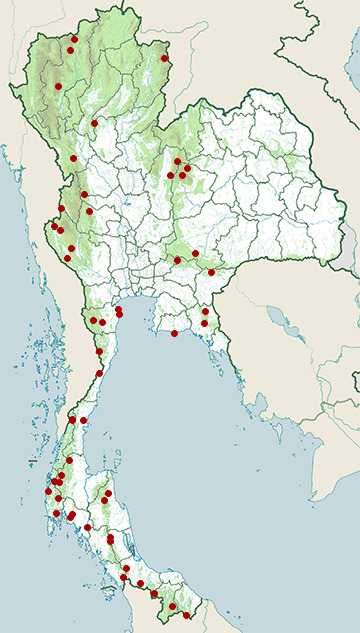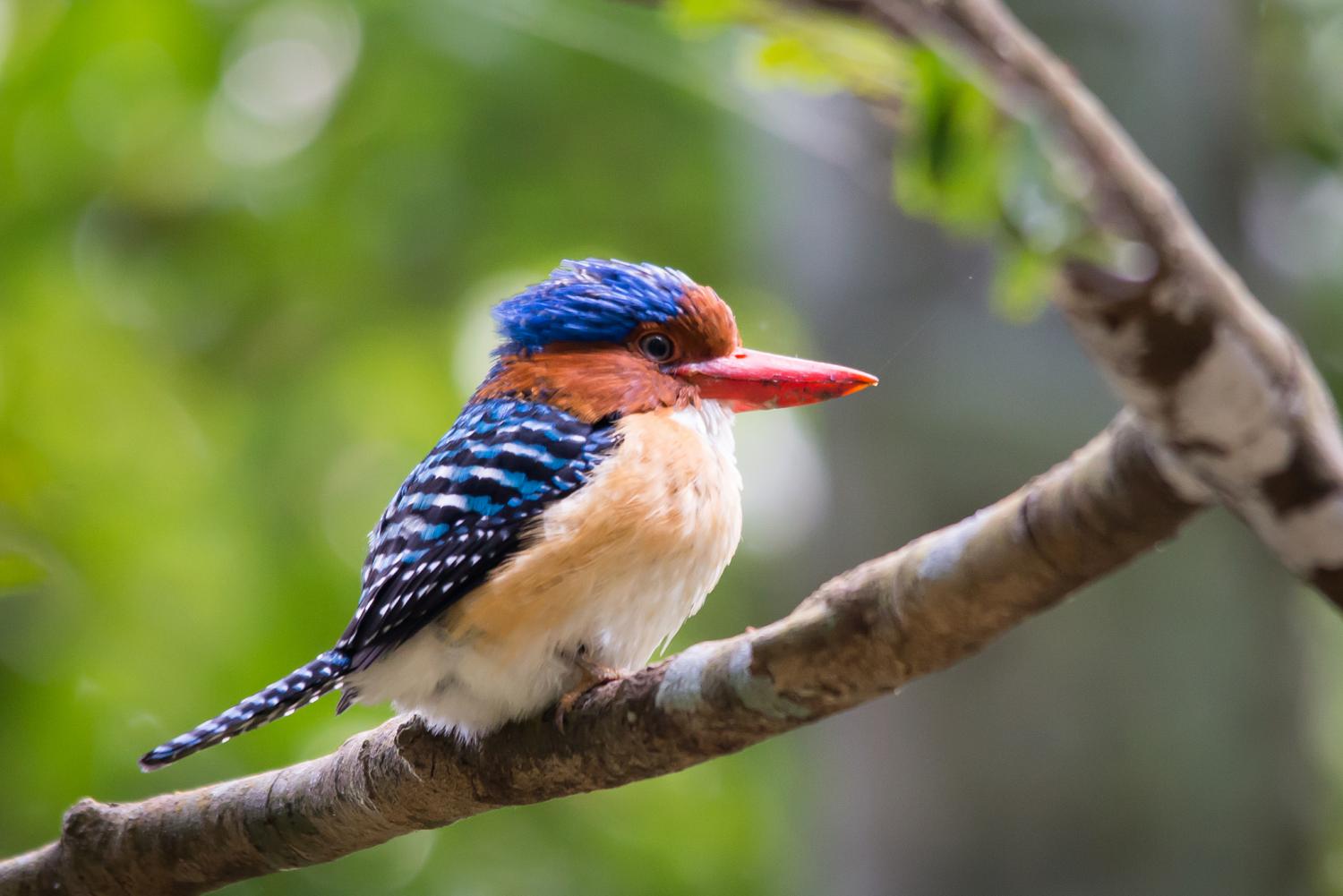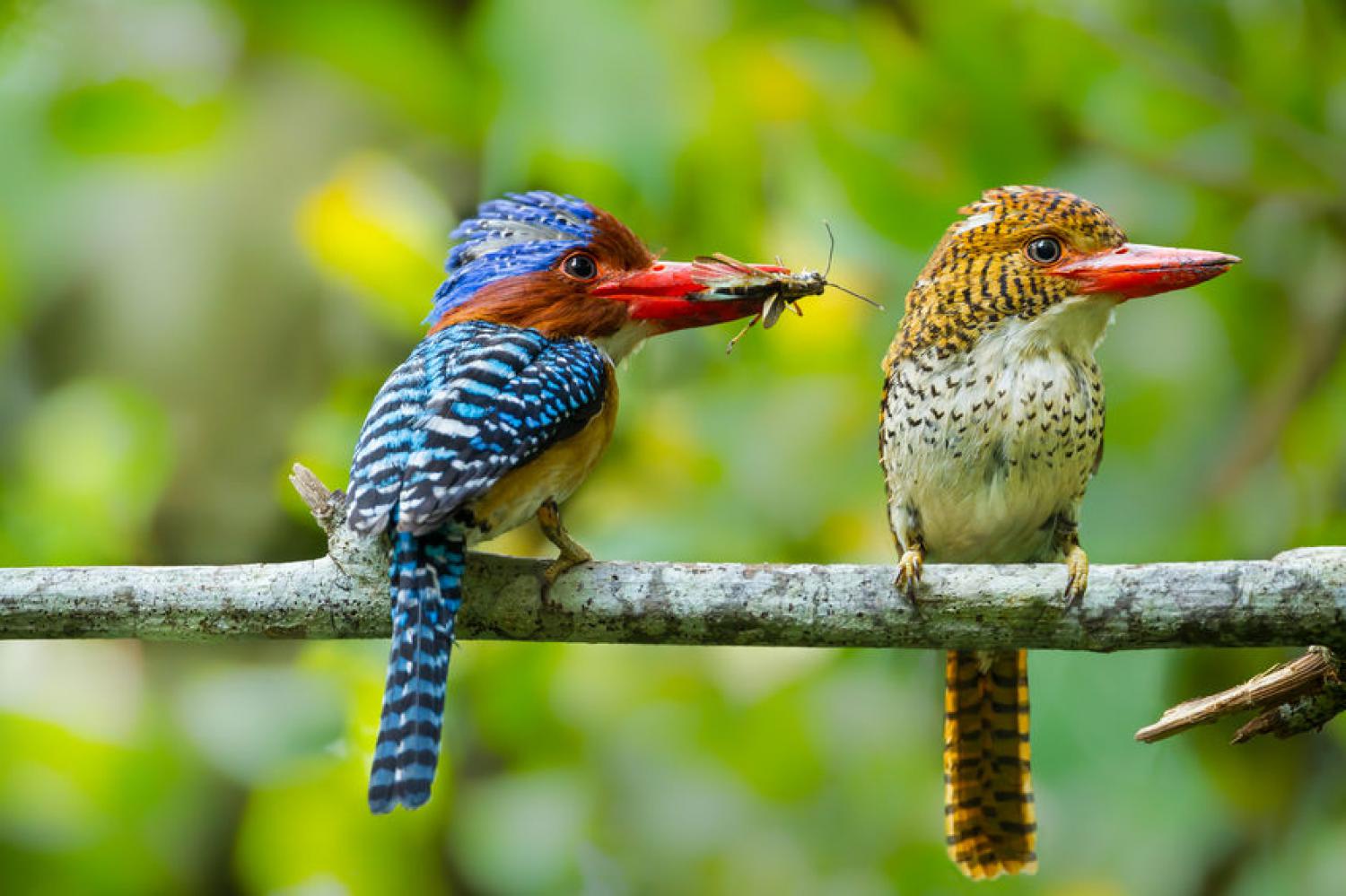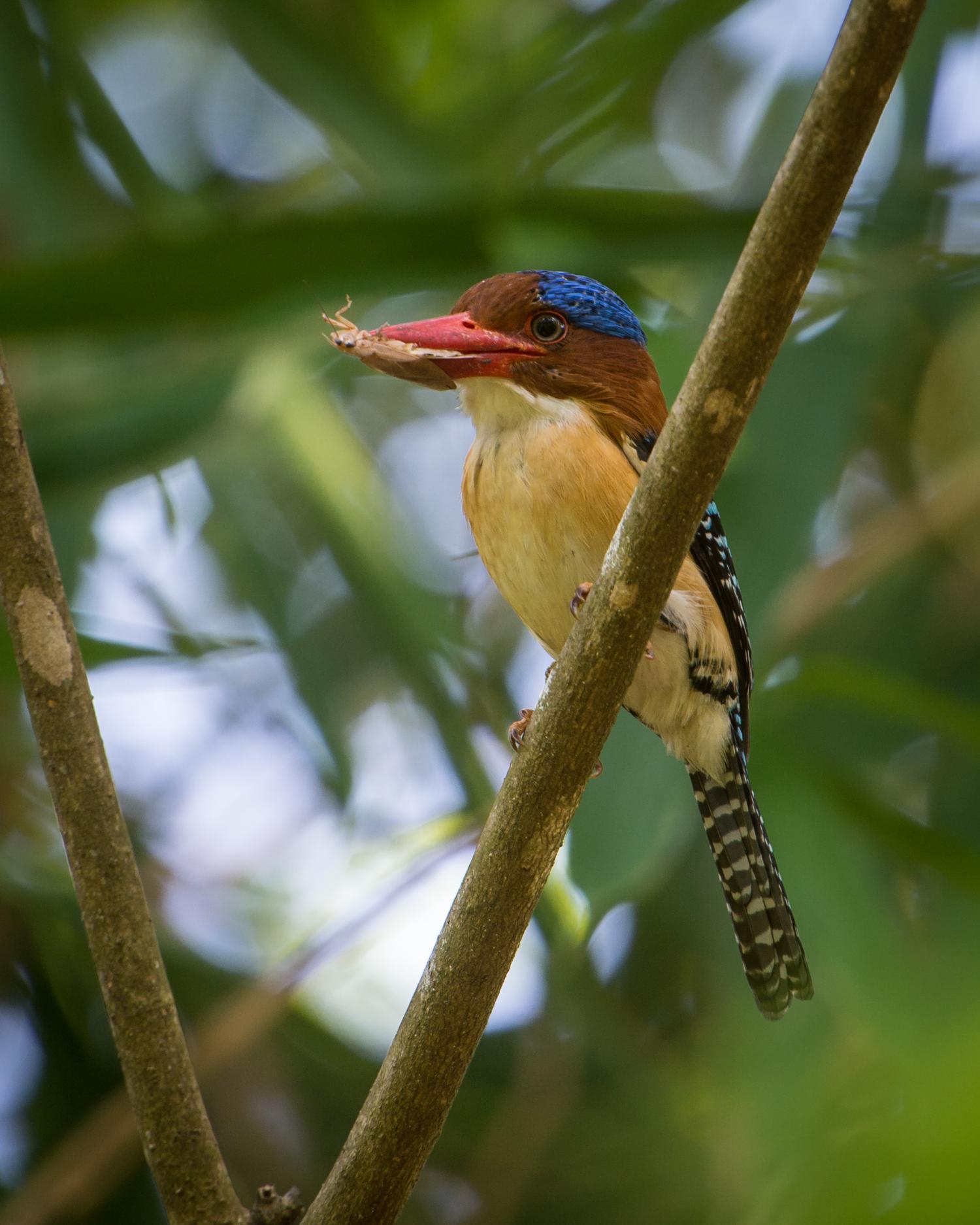Species of Thailand
Banded kingfisher
Lacedo pulchella
Thomas Horsfield, 1821
In Thai: นกกะเต็นลาย
The banded kingfisher (Lacedo pulchella) is a tree kingfisher found in lowland tropical forests of southeast Asia. It is the only member of the genus Lacedo. Male and female adults are very different in plumage. The male has a bright blue crown with black and blue banding on the back. The female has rufous and black banding on the head and upperparts.
Taxonomy
The first formal description of the species was by the American naturalist Thomas Horsfield in 1821 under the binomial name Dacelo pulchella. The current genus Lacedo was introduced by the German ornithologist Ludwig Reichenbach in 1851. The word Lacedo is an anagram of Alcedo, the Latin word for kingfisher. The specific name pulchella is Latin for "very pretty".
There are three subspecies:
- L. p. pulchella, the nominate race, breeds in Malaysia south of 7°N and on the islands of Sumatra and Java.
- L. p. amabilis breeds from northern Malaysia northwards. It is slightly larger than the nominate form. The male has a blue nape, and the female is more rufous than pulchella.
- L. p. melanops breeds in Brunei. The male has a black forehead, cheeks and nape.
Description
The banded kingfisher is a 20 cm long with a sturdy red bill and a short crest which is slowly raised and lowered. It shows striking sexual dimorphism compared to most of its relatives. The adult male has a chestnut forehead, cheeks and nape, and a bright blue cap. The rest of the upperparts, wings and tail are black with blue bands. The breast, flanks and undertail are rufous, and the central belly is white.
The adult female is equally striking, with black-and-rufous-banded upperparts, and white underparts with some black bars on the chest and flanks. Young birds are duller than the adult of the same sex, have a brown and orange bill, and dusky barring on the underparts.
The call is a long whistled wheeeoo followed by 15 repetitions of chiwiu in 17 seconds, the second syllable gradually fading away. The banded kingfisher will respond to imitations of its call.
Distribution and habitat
The species occurs in Myanmar, Thailand, Cambodia, Vietnam, Laos, Malaysia, Sumatra, Java and Brunei. It is extinct in Singapore.
Behaviour
This is a bird of lowland rainforest found up to 1, 700 m in Brunei, but normally below 1100 m altitude in the rest of its range. Unlike most kingfishers, it does not need pools or streams in its territory.
The nest is a hole in a rotting tree trunk, or sometimes in the spherical nest of tree termites. Two to five white eggs are laid. In Thailand the eggs are laid between February and May.
The banded kingfisher hunts large insects and occasionally small lizards, usually taken in the trees, but sometimes from the ground.
Status
This species is uncommon but widespread in much of its range. It is rare in Java, very rare in Sumatra and extinct in Singapore.
This article uses material from Wikipedia released under the Creative Commons Attribution-Share-Alike Licence 3.0. Eventual photos shown in this page may or may not be from Wikipedia, please see the license details for photos in photo by-lines.
Category / Seasonal Status
BCST Category: Recorded in an apparently wild state within the last 50 years
BCST Seasonal status: Resident or presumed resident
Scientific classification
- Kingdom
- Animalia
- Phylum
- Chordata
- Class
- Aves
- Order
- Coraciiformes
- Family
- Alcedinidae
- Genus
- Lacedo
- Species
- Lacedo pulchella
Common names
- Thai: นกกะเต็นลาย
Subspecies
Lacedo pulchella amabilis, Allan Octavian Hume, 1873
Range: Breeds from northern Malaysia northwards. It is slightly larger than the nominate form. The male has a blue nape, and the female is more rufous than pulchella.
Lacedo pulchella melanops, Charles Lucien Bonaparte, 1850
Range: Breeds in Brunei. The male has a black forehead, cheeks and nape.
Lacedo pulchella pulchella (nominate), Thomas Horsfield, 1821
Range: Breeds in Malaysia south of 7°N, Sumatra and Java.
Conservation status

Least Concern (IUCN3.1)
Photos
Please help us review the bird photos if wrong ones are used. We can be reached via our contact us page.
Range Map

- Ao Phang-Nga National Park
- Bang Lang National Park
- Chiang Dao Wildlife Sanctuary
- Doi Inthanon National Park
- Hala-Bala Wildlife Sanctuary
- Huai Kha Khaeng Wildlife Sanctuary
- Huai Yang Waterfall National Park
- Kaeng Krachan District, Phetchaburi
- Kaeng Krachan National Park
- Kaeng Krung National Park
- Khao Banthat Wildlife Sanctuary
- Khao Khitchakut National Park
- Khao Laem National Park
- Khao Laem Ya - Mu Ko Samet National Park
- Khao Luang National Park
- Khao Nam Khang National Park
- Khao Nan National Park
- Khao Phanom Bencha National Park
- Khao Phra - Bang Khram Wildlife Sanctuary
- Khao Pu - Khao Ya National Park
- Khao Soi Dao Wildlife Sanctuary
- Khao Sok National Park
- Khao Yai National Park
- Khlong Saeng Wildlife Sanctuary
- Khon San District, Chaiyaphum
- Khun Nan National Park
- Kromluang Chumphon Wildlife Sanctuary
- Kui Buri National Park
- Laem Pak Bia
- Mae Wong National Park
- Mueang Chumphon District, Chumphon
- Mueang Krabi District, Krabi
- Nam Nao National Park
- Pak Thale
- Pang Sida National Park
- Pha Daeng National Park
- Phu Khiao Wildlife Sanctuary
- Sai Yok National Park
- Sakaerat Environmental Research Station
- San Kala Khiri National Park
- Sangkhla Buri District, Kanchanaburi
- Si Satchanalai National Park
- Sri Nakarin Dam National Park
- Sri Phang-nga National Park
- Taksin Maharat National Park
- Takua Pa District, Phang Nga
- Tat Mok National Park
- Thale Ban National Park
- Thung Yai Naresuan Wildlife Sanctuary
- Ton Nga-Chang Wildlife Sanctuary
- Ton Pariwat Wildlife Sanctuary
- Wang Mai Forest Restoration Project


